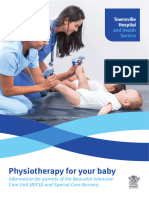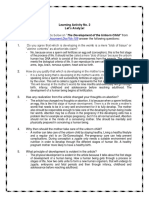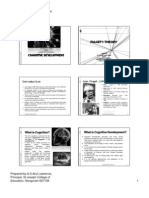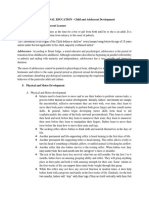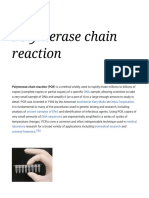Evaluation of Carrying Position For Babies
Evaluation of Carrying Position For Babies
Copyright:
Available Formats
Evaluation of Carrying Position For Babies
Evaluation of Carrying Position For Babies
Original Description:
Original Title
Copyright
Available Formats
Share this document
Did you find this document useful?
Is this content inappropriate?
Copyright:
Available Formats
Evaluation of Carrying Position For Babies
Evaluation of Carrying Position For Babies
Copyright:
Available Formats
IOSR Journal of Nursing and Health Science (IOSR-JNHS)
e-ISSN: 23201959.p- ISSN: 23201940 Volume 3, Issue 6 Ver. III (Nov.-Dec. 2014), PP 47-51
www.iosrjournals.org
Evaluation of Carrying Position for Babies
Mrs.J.Rajalakshmi, Dr.Kebede Legesse ,
Bsc , Msc nursing, lecturer in ambo university
MD , dean , medical science department, ambo university
Keywords
-Introduction
-Difference
-Rock
a-babyInfant
spine
development
-Science
view
I.
Introduction
Modern notions in biology have also led to the human infant being classified as
belonging to the carried type of young (i.e., infants that are typically carried on
the bodies of their mothers), in contrast to the offspring of other mammals that
are generally left in a hidden place (i.e., nested or cached. This view is based on
evolutionary, particularly anatomical, considerations, and is substantiated by
young infants typical reactions when parted from their caregivers. human
infants still display many striking characteristics of a carried young. Like a
gorilla baby, the human infant, when lying on the back, frequently assumes a
position where both legs are flexed and abducted (Figure 1). This position is also
adopted when the lying or sitting child is lifted up (Figure 2) and allows the child
to be placed astride the caregivers hip, nestled against the carriers body
based
-Learning to carry
a baby
-Different methods
of carrying a baby
-Nine reasons not
to carry
www.iosrjournals.org
47 | Page
Evaluation of Carrying Position for Babies
II.
Difference Between Baby Carrying By Foraging, Nomadic Peoples,
Horticulturalists.
nomadic mothers, the
decision has always been
whether it is safe to leave her
baby with another carer, and
whether she will return in
time to feed him.
III.
For a foraging mother to
remain in close enough
proximity to nurse could
require carrying babies plus
supplies and gathered
provender back-breaking
distances.
. Whilst women were
grinding cereals against a
stone, her baby might be
held by an allo mother,
cradled nearby, or wrapped
on to her mothers back using
a sling arrangement.
Rock-A-Baby By Swaddling:
3.1Infant spine development:
Our spine is not perfectly straight, even though it may appear so from the front or back . When you
look at a person from the side, four slight curves are visible, forming an elongated S shape. These curves help
keep us flexible and balanced. At birth, babies are in a state of flexion, still curled up, with their spine in a
natural long c-shaped (convex) curve. At first, a baby does not have the strength to hold his head up, nor the
balancing curves in his spine to do so. But gradually as the muscles in his neck get stronger, he begins to lift his
heavy head against gravity, and a curve starts to develop in his neck (the cervical curve) to help balance his
head.
www.iosrjournals.org
48 | Page
Evaluation of Carrying Position for Babies
At Birth: The spine of an infant is C-shaped (a convex
curve). He has neither the balancing curves nor the
strength to his head upright
First Several Months: As your infant works against
gravity his muscles start to develop. Strong neck
muscles helpaninfant hold up a heavy head forming
the neck (cervical) curve of the spine.
Six Months to One Year: As an infant learns to crawl
and stand, the lower back (lumbar) curve and his
muscles develop so that he can stand upright. When
he walks away from you on his own, only then are all
of his curves developed.
IV.
Ages & Stages: A Science-Based View On Baby Carrying Positions
4.1 Need For Brain Stimulation:
The great amount of research done on the babys developing brain is indeed how vital appropriate
stimulation is. When the baby is born, the number of neurons in its brain corresponds to adults. However, what
is missing is the mindboggling amount of connections that will eventually shape that particular babys
personality and intelligence. These connections are formed by and are utterly dependent on the type of stimuli
that the baby receives from the outside world. Every experience the baby is exposed to will activate some part of
the brains neurons. The more frequently a given experience occurs, the stronger the connections between the
activated neurons become. As neuroscientists sometimes say: Cells that fire together, wire together. we need
to look at the major developmental phases that a baby goes through in her first year.
4.2 Three Stages Of Babys Development:
In the first few months after birth, the babys main developmental task is adaption to life outside the
womb. A variety of basic functions have to be mastered: suckling, digesting, breathing, vocalizing, defecating,
and seeing.
At around 2-3 months of age, the baby begins to actively seek out social exchanges with adults, using
its glance and smile to attract attention and initiate conversations or playful episodes. This marks the beginning
of a phase, lasting about three or four months (age 2-6 months) where the baby is intensely interested in the
human face.
From around 6 months of age, with the emergence of eye-hand coordination, the babys attention gradually
switches towards the world of objects.. Their primary role becomes to help the baby decipher and interpret
ambiguous situations where the baby feels insecure.
V.
1.
2.
3.
4.
5.
6.
7.
8.
Learning To Carry Your Baby:
choosing the carrying methods suitable for his or her age.
your baby should be able to rest on his buttocks with his legs apart and raised in what is called a "frog"
position.
His back should be bent and not straight, and his head should rest on your chest.
always carry your baby against your abdomen, facing you, or on your back.
The position looking out onto the world allows him to look at everything but it does not respect the curve of
his back
If you get backache, your wrap is no doubt tied incorrectly or your baby carrier is not adjusted correctly
baby carrying requires a few days to a few weeks of practice for you and your baby to get used to and
become perfectly at ease with.
It helps some babies to breastfeed better. Some babies, particularly those who are tense or tend to arch their
backs, breastfeed better while moving.
www.iosrjournals.org
49 | Page
Evaluation of Carrying Position for Babies
5.1 Advantages:
1. Carrying method that reduces crying and colic of baby . A 1986 study of 99 mother-infant pairs (reported
in Pediatrics) showed that carrying babies at least three hours a day reduces crying and fussing 43%
during the day and 51% at night.
2. It enhances learning. Carried babies have enhanced visual and auditory alertness, and increased quiet
alertness times.
3. Carrying a baby promotes cognitive development and speech development, since babies are exposed to
more experiences and conversations.
4. Carrying your baby promotes bonding and enhances parents feelings of competence. A higher frequency
of feeding and touching stimulates mothering hormones, and frequent carrying encourages and speeds the
development of a mutual reading of each others cues.
5. When infants are held upright, The force of gravity is a positive element in infant development. It allows
them to learn to hold their heads up and keep their bodies balanced.
6. Carrying a young infant in the horizontal position with legs together in a baby carrier (like a sling or a
wrap) provides adequate spinal support
7. Upright baby carriers that support the legs, carrying a baby as a mother naturally would in arms, do not
compromise a babys spine or hips. When an infants legs are flexed and straddled, the instinctive position
that his little body assumes when picked up, the head of his femur (bone of the thigh) fills out the hip
socket (acetabulum)
8. Proponents of horizontal positioning in early infancy may be concerned with whether the infant actually
receives adequate levels of oxygen while being carried by mother
9.
carried babies receive a lot of vestibular stimulation, whereas lying babies do not. Our vestibular system
helps us out with our sense of balance and our security in space. When a mother holds her baby, the baby
moves back and forth with moms walking, and side to side from her swaying or rocking.
10. Vertical positioning as optimal in infants makes perfect sense. Think ,if the infants spend horizontalflat
on their back in a crib or a buggy. Might this affect their alertness.
VI.
Different Methods Of Carrying A Baby:
www.iosrjournals.org
50 | Page
Evaluation of Carrying Position for Babies
6.1 Nine Reasons Not To Carry Your Baby Facing Out:
1. does not support your babys legs.
2. makes it tough for the wearer to carry the baby.
3. places your baby in an arched or hollow back position which places pressure on the spine , groin and may
chafe the inner thighs of your baby.
4. may over stimulate your baby.
5. doesnt support the head or the neck leads to Positional asphyxia
6. makes thermoregulation more difficult.
7. makes it harder to respond to babys cues.
8. throws off babys center of gravity.
9. may not be so wonderful on your back either.
VII.
Conclusion
In conclusion, conventional baby carrying may reduce the amount of crying. If your baby has colic or
you would like to preempt the onset of colic, you could practice carrying in the same manner as many
indigenous people, with skin-to-skin contact, just make sure that you are there for your baby, and that you have
someone who is there for you as well, so you can go through this challenging phase with a strengthened love for
your baby and for one another. Colic will pass for your baby.
Reference:
[1].
[2].
[3].
[4].
[5].
[6].
[7].
[8].
[9].
[10].
[11].
[12].
[13].
[14].
[15].
[16].
Alvarez M. Caregiving and Early Infant Crying in a Danish Community. Developmental and Behavioral Pediatrics Vol. 25, No. 2,
April 2004
Barr RG, McMullan SJ, Spiess H, Leduc DG, Jaremko, J, Barfield R, Francouer E & Hunziker UA. Carrying as Colic Therapy: A
Randomized Controlled Trial. Pediatrics, Vol 87, 5 1991. P. 623-630
Bennedbaek O, Viktor J, Carlsen KS, Roed H, Vinding H, Lundbye-Christensen S. Infants with colic. A heterogenous group
possible to cure? Treatment by pediatric consultation followed by a study of the effect of zone therapy on incurable colic. Ugeskr
Laeger. 2001 Jul 2; 163(27):3773-8. (In Danish, abstract available in English)
Bowen JR & Kotzias-Neto A. 2006. Developmental dysplasia of the hip. Data Trace Publishing Company. ISBN. 1-57400-108-6.
Hewlett B, Lamb ME, Shannon D, Leyendecker B & Scholmerich A. Culture and Early Infancy Among Central African Foragers
and Farmers. Developmental Psychology 1998 \fcl. 34, No. 4, 653-661
Hunziker UA & Barr RG. Increased Carrying Reduces Crying: A Randomized Controlled Trial. Pediatrics, Vol 75, 5 1986. P. 641648.
Landgren K, Kvorning N, Hallstrom I. Acupuncture reduces crying in infants with infantile colic: a randomized controlled, blind
clinical study. Acupuncture Med 2010; 28:174179. doi:10.1136/aim.2010.002394
Kirkilionis. E. 1997. Die Grundbedrfnisse des Suglings und deren medizinische Aspekte. Teil 1. Notabene Medici 2, p. 61-66.
Kirkilionis. E. 1997. Die Grundbedrfnisse des Suglings und deren medizinische Aspekte. Teil 2. Notabene Medici 3, p. 117-121.
Mahan ST & Kasser JR. 2008. Does swaddling influence developmental dysplasia of the hip? Pediatrics 121;177-178
Salter R. 1968. Etiology, pathogenesis and possible prevention of congenital dislocation of the hip. Can. Med. Assoc. 98; 933-945
St James-Roberts I. Infant Crying and Sleeping: Helping Parents to Prevent and Manage Problems. Prim Care Clin Office Pract 35
(2008) 547567
St James-Roberts I, Alvarez M, Csipke E, Abramsky T, Goodwin J & Sorgenfrei E. Infant Crying and Sleeping in London,
Copenhagen and When Parents Adopt a Proximal Form of Care. Pediatrics 2006; 117; e1146-e1155
Wessel MA, Cobb JC, Jackson EB, Harris GS, Detwiler AC. Paroxysmal fussing in infancy, sometimes called colic.
Pediatrics 1954, 14:421-435.
International Hip Dysplasia Institute. http://www.hipdysplasia.org/default.aspx
Internet resources: http://www.somatics.de/TraumaSomatics07.pdf
www.iosrjournals.org
51 | Page
You might also like
- Torticollis and Your BabyDocument14 pagesTorticollis and Your BabySham ObaidatNo ratings yet
- Untangling The Mystery of Algal Blooms in The Great LakesDocument5 pagesUntangling The Mystery of Algal Blooms in The Great LakesKavyaNo ratings yet
- Developmental AssessmentDocument13 pagesDevelopmental AssessmentIsaac Tan100% (3)
- Lab Report - Phloem & XylemDocument6 pagesLab Report - Phloem & XylemAriadna ApolonioNo ratings yet
- Case Report ScoliosisDocument67 pagesCase Report ScoliosisNurul Husna RashidNo ratings yet
- Strollers, Baby Carriers, and Infant Stress:: Horizontal Versus Upright Transport in Early InfancyDocument25 pagesStrollers, Baby Carriers, and Infant Stress:: Horizontal Versus Upright Transport in Early Infancymarkus_danusantosoNo ratings yet
- Physiotherapy For Your BabyDocument9 pagesPhysiotherapy For Your Babydinny godsonNo ratings yet
- Lec 7 & 8 - Infancy Physical and SocioEmotional DevelopmentDocument23 pagesLec 7 & 8 - Infancy Physical and SocioEmotional Developmentraoaiman862No ratings yet
- BBSling User ManualDocument20 pagesBBSling User Manualmelissa2826No ratings yet
- Examples of Physical Development MilestonesDocument10 pagesExamples of Physical Development MilestonesJeko Betguen Palangi100% (1)
- Educ 101.module 12Document10 pagesEduc 101.module 12Avigale VelascoNo ratings yet
- Part II Development of The Learners at Various Stage Physical Development of Infant and Toddlers PDFDocument24 pagesPart II Development of The Learners at Various Stage Physical Development of Infant and Toddlers PDFEvangeline Pederoso SolomonNo ratings yet
- Artículo 2010-Cinical-Lactation-ColsonDocument4 pagesArtículo 2010-Cinical-Lactation-Colsonalba98navarroNo ratings yet
- Notes On INFANCY AND BABYHOODDocument18 pagesNotes On INFANCY AND BABYHOODBlessie NgitngitNo ratings yet
- Broshurebabywearingblack White2009Document2 pagesBroshurebabywearingblack White2009Haryati YaacobNo ratings yet
- Olam and PorrasDocument16 pagesOlam and Porrasdaniellekateolam64No ratings yet
- MODULE 7 - Infancy and ToddlerhoodDocument22 pagesMODULE 7 - Infancy and ToddlerhoodRachelle DalingNo ratings yet
- MODULE 12: Physical Development of Infants and Toddlers: Cephalocaudal and Proximodistal PatternDocument3 pagesMODULE 12: Physical Development of Infants and Toddlers: Cephalocaudal and Proximodistal PatternThamiah Izabell Odena50% (4)
- Guide To Tummy Time O9hqltDocument29 pagesGuide To Tummy Time O9hqltmasayyya12No ratings yet
- BreastfeedingDocument8 pagesBreastfeedingjolibeecaldonaNo ratings yet
- Educ10 Module12Document7 pagesEduc10 Module12dumamag.sandarahkylahNo ratings yet
- Learning Material 6. DCAD - Physical, Cognitive, Social and Emotional Dimension (Infancy Toddlerhood)Document24 pagesLearning Material 6. DCAD - Physical, Cognitive, Social and Emotional Dimension (Infancy Toddlerhood)Gio ManuelNo ratings yet
- Orca Share Media1581242252384Document647 pagesOrca Share Media1581242252384Laila UbandoNo ratings yet
- Biological Beginnings - Learning ExercisesDocument4 pagesBiological Beginnings - Learning ExercisesNnieh KhuuNo ratings yet
- Infancy and ToddlerhoodDocument25 pagesInfancy and ToddlerhoodMark SultanNo ratings yet
- Guide QuestionsDocument4 pagesGuide QuestionsMicah YapNo ratings yet
- Physical Development of Infants and ToddlersDocument30 pagesPhysical Development of Infants and ToddlersDiana Garcia SaclutiNo ratings yet
- Module 9 Newborn & InfancyDocument10 pagesModule 9 Newborn & InfancyBruit, Marian Joy M.No ratings yet
- EbookDocument9 pagesEbookod armyNo ratings yet
- Prenatal Development NotesDocument12 pagesPrenatal Development NotesMrudula ArunNo ratings yet
- Module 5 - The Child and Adolescent Learners and Learning PrinciplesDocument18 pagesModule 5 - The Child and Adolescent Learners and Learning PrinciplesMarkhill Veran Tiosan100% (1)
- (MIOMIO) ALL Types of Position (Breastfeeding)Document12 pages(MIOMIO) ALL Types of Position (Breastfeeding)Juliet Marie MiomioNo ratings yet
- Cognitive Development PiagetDocument7 pagesCognitive Development PiagetARUL LAWRENCE100% (1)
- Development of The Learners at Various Stages: Unit 2: Infancy and ToddlerDocument7 pagesDevelopment of The Learners at Various Stages: Unit 2: Infancy and ToddlerDarlene Dacanay DavidNo ratings yet
- Infancy and ToddlerhoodDocument156 pagesInfancy and ToddlerhoodIrene Pulas100% (1)
- Physical Development of Infants and ToddlersDocument31 pagesPhysical Development of Infants and ToddlersNeth CaparosNo ratings yet
- Physical Development of Infant and Toddler - Jayson CajalaDocument44 pagesPhysical Development of Infant and Toddler - Jayson CajalaJessie CajalaNo ratings yet
- PROF-ED-102-SG-11Document6 pagesPROF-ED-102-SG-11Maria PearlNo ratings yet
- InfancyDocument64 pagesInfancysiddiquimahrukh82No ratings yet
- Masterfile Let ReviewerDocument644 pagesMasterfile Let ReviewerApril Claire Pineda Manlangit50% (4)
- Child and Adolescent DevelopmentDocument19 pagesChild and Adolescent DevelopmentBenedickNo ratings yet
- Physical Development of Infants and ToddlersDocument21 pagesPhysical Development of Infants and ToddlersSierra May AnceroNo ratings yet
- Early Clinical Assessment of Balance (ECAB) PDFDocument8 pagesEarly Clinical Assessment of Balance (ECAB) PDFdeviNo ratings yet
- Born To Move 00682Document12 pagesBorn To Move 00682julieNo ratings yet
- Infancy - I: Add Your Name HereDocument23 pagesInfancy - I: Add Your Name HereJayanth MamundiNo ratings yet
- Physical Development of Infants and ToddlersDocument5 pagesPhysical Development of Infants and ToddlersNathalie Getino100% (1)
- Positioning in NICUDocument5 pagesPositioning in NICUMahera KantawallaNo ratings yet
- EDUC102 Module 10Document10 pagesEDUC102 Module 10Ernest Hans MaigueNo ratings yet
- "Crawling": Why Is Crawling Important?Document4 pages"Crawling": Why Is Crawling Important?Irish Llesis AnsinNo ratings yet
- Inbound 5443687953894507938Document67 pagesInbound 5443687953894507938Princess Nicole FelicesNo ratings yet
- InfancyDocument45 pagesInfancypootharekuluchowkeNo ratings yet
- Prof Ed N5 Child and AdolescentDocument20 pagesProf Ed N5 Child and Adolescentarmand rodriguezNo ratings yet
- Lecture-Notes 2 CADDocument10 pagesLecture-Notes 2 CADJomar MendrosNo ratings yet
- Physical, Emotional & Social Development (Final)Document12 pagesPhysical, Emotional & Social Development (Final)api-19846552No ratings yet
- Key Milestones for Growing Up Fast: Essential Insights for Tracking and Supporting Your Baby's Development for the first 6 monthsFrom EverandKey Milestones for Growing Up Fast: Essential Insights for Tracking and Supporting Your Baby's Development for the first 6 monthsNo ratings yet
- Raising Bright Sparks- Book 1. Parenting Gifted ChildrenFrom EverandRaising Bright Sparks- Book 1. Parenting Gifted ChildrenNo ratings yet
- Understanding Your Baby's Milestone Moment: A Practical Guide to Nurturing Growth and Skills During Key Developmental Stages for Your Infant's Progress from 7 to 10 MonthsFrom EverandUnderstanding Your Baby's Milestone Moment: A Practical Guide to Nurturing Growth and Skills During Key Developmental Stages for Your Infant's Progress from 7 to 10 MonthsNo ratings yet
- Baby Ecology: Using Science and Intuition to Create the Best Feeding, Sleep, and Play Environment for Your Unique BabyFrom EverandBaby Ecology: Using Science and Intuition to Create the Best Feeding, Sleep, and Play Environment for Your Unique BabyNo ratings yet
- The Truth About Tummy Time: A Parent's Guide to Sids, the Back to Sleep Program, Car Seats and More.From EverandThe Truth About Tummy Time: A Parent's Guide to Sids, the Back to Sleep Program, Car Seats and More.No ratings yet
- Effects of Formative Assessment On Mathematics Test Anxiety and Performance of Senior Secondary School Students in Jos, NigeriaDocument10 pagesEffects of Formative Assessment On Mathematics Test Anxiety and Performance of Senior Secondary School Students in Jos, NigeriaInternational Organization of Scientific Research (IOSR)100% (1)
- Necessary Evils of Private Tuition: A Case StudyDocument6 pagesNecessary Evils of Private Tuition: A Case StudyInternational Organization of Scientific Research (IOSR)No ratings yet
- Youth Entrepreneurship: Opportunities and Challenges in IndiaDocument5 pagesYouth Entrepreneurship: Opportunities and Challenges in IndiaInternational Organization of Scientific Research (IOSR)100% (1)
- Comparison of Explosive Strength Between Football and Volley Ball Players of Jamboni BlockDocument2 pagesComparison of Explosive Strength Between Football and Volley Ball Players of Jamboni BlockInternational Organization of Scientific Research (IOSR)No ratings yet
- Factors Affecting Success of Construction ProjectDocument10 pagesFactors Affecting Success of Construction ProjectInternational Organization of Scientific Research (IOSR)No ratings yet
- Design and Analysis of Ladder Frame Chassis Considering Support at Contact Region of Leaf Spring and Chassis FrameDocument9 pagesDesign and Analysis of Ladder Frame Chassis Considering Support at Contact Region of Leaf Spring and Chassis FrameInternational Organization of Scientific Research (IOSR)No ratings yet
- Fatigue Analysis of A Piston Ring by Using Finite Element AnalysisDocument4 pagesFatigue Analysis of A Piston Ring by Using Finite Element AnalysisInternational Organization of Scientific Research (IOSR)No ratings yet
- Pulsoximetro FingertipDocument2 pagesPulsoximetro FingertipJuanse AlcazarNo ratings yet
- Temperate Woodland / Shrubland BiomeDocument16 pagesTemperate Woodland / Shrubland BiomeGomonan RosannaNo ratings yet
- Los Sulfuros Masivos Volcanogénicos de La Cuenca Lancones (Perú)Document4 pagesLos Sulfuros Masivos Volcanogénicos de La Cuenca Lancones (Perú)Jonathan Rivera BecerraNo ratings yet
- Dipterocarpaceae (Flora of Sarawak and Sabah)Document338 pagesDipterocarpaceae (Flora of Sarawak and Sabah)fakh90No ratings yet
- Reading About CellsDocument5 pagesReading About CellsKavita JaiNo ratings yet
- Documents - Pub Chapter 8 Animal Like Protists The Protozoa Evolutionary Perspective of TheDocument31 pagesDocuments - Pub Chapter 8 Animal Like Protists The Protozoa Evolutionary Perspective of TheKamran AhmedNo ratings yet
- Managing Innovations in Biotechnology: Uropean Project Semester 2006Document77 pagesManaging Innovations in Biotechnology: Uropean Project Semester 2006heeraNo ratings yet
- The Domestication of Horses Reading AnswersDocument4 pagesThe Domestication of Horses Reading AnswersZokirjon Chorshanbiyev100% (3)
- Skeletal System NOTADocument2 pagesSkeletal System NOTAVan PersieNo ratings yet
- Polymerase Chain Reaction - WikipediaDocument36 pagesPolymerase Chain Reaction - Wikipedia93428ZEFHDNo ratings yet
- M2 - L2. Cell Cycle and Cell DivisionDocument2 pagesM2 - L2. Cell Cycle and Cell DivisionPrincess Paula ArguidasNo ratings yet
- Networking Brainstem and Basal Ganglia Circuits For MovementDocument19 pagesNetworking Brainstem and Basal Ganglia Circuits For MovementIeremi AtomoNo ratings yet
- The.8.concepts - of.M.B Cp4afin - RED PDFDocument43 pagesThe.8.concepts - of.M.B Cp4afin - RED PDFbladNo ratings yet
- Topic - 2 Tissue - BiologyDocument31 pagesTopic - 2 Tissue - Biologyshekharswami0464No ratings yet
- Purification of Protease Enzyme From The Leaf, Seed and Pod Samples ofDocument8 pagesPurification of Protease Enzyme From The Leaf, Seed and Pod Samples ofKikyNo ratings yet
- PhysioEx Exercise 5 Activity 1Document3 pagesPhysioEx Exercise 5 Activity 1villanuevaparedesaracely4No ratings yet
- GDE Gr.11 Life Sciences ATP Term 1 2024Document3 pagesGDE Gr.11 Life Sciences ATP Term 1 2024destineemande070% (1)
- Download Complete Anatomy and Histology of the Laboratory Rat in Toxicology and Biomedical Research Robert L Maynard PDF for All ChaptersDocument55 pagesDownload Complete Anatomy and Histology of the Laboratory Rat in Toxicology and Biomedical Research Robert L Maynard PDF for All Chaptersoppenseavybt100% (1)
- Ijsrp p11674Document13 pagesIjsrp p11674aman babuNo ratings yet
- Bar A May Protocal ManualDocument8 pagesBar A May Protocal ManualartaveNo ratings yet
- HBV PCRDocument38 pagesHBV PCRAlida NihayahNo ratings yet
- Beat Psoriasis Simple and Effective Treatment - The Natural WayDocument156 pagesBeat Psoriasis Simple and Effective Treatment - The Natural WayUGKUGIGNo ratings yet
- Namaqualand After RainDocument12 pagesNamaqualand After RainUfufhNo ratings yet
- Corn Steep Liquor To Remedy The Polluted SoilDocument21 pagesCorn Steep Liquor To Remedy The Polluted SoilMengmeng WangNo ratings yet
- Late ChildhoodDocument28 pagesLate ChildhoodAndreah PelingonNo ratings yet
- Genetics Problems - Grade 11: Monohybrid CrossesDocument4 pagesGenetics Problems - Grade 11: Monohybrid CrossessiennaNo ratings yet
- E Coli-PowerpointDocument29 pagesE Coli-PowerpointThrina Gynae CondezNo ratings yet






